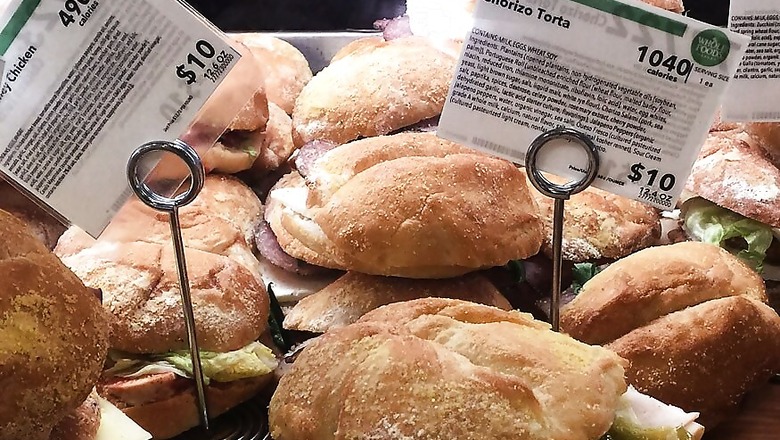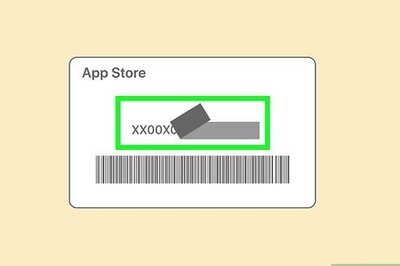
views
Calorie counts are popping up on some restaurant menus and for prepared foods at supermarkets, whether you want to see them or not.
A federal regulation requiring food sellers to post the nutrition numbers by Friday was postponed again this week until 2018, after years of delays amid opposition from pizza chains, convenience stores and grocers. But many chains had been scrambling to comply, and say they don't plan to alter course right now.
"We were running hard toward the Friday deadline," said Keith Dailey, a spokesman for Kroger, in an email.
Kroger Co., which operates chains including Ralph's and Fry's, said it plans to be "mostly" compliant by this week. Albertsons, which owns Safeway and Vons, also said shoppers will find calorie counts for prepared foods like cut fruit, salads and muffins. The company's Jewel-Osco chain is also sticking with plans to do so, the Chicago Tribune reported earlier this week.
At Whole Foods in New York this week, calorie counts were posted on most hot food and salad bar items, and the chain said it's still committed to this week's deadline.
An Indian chicken dish at its hot food bar was listed at 130 calories for a 3-ounce serving, and a rice dish was listed at 120 calories per 4-ounce serving. The signs didn't indicate what those serving sizes look like. In the prepared food section, a Mediterranean turkey meatball had 730 calories and a regular meatball in red sauce had 520.
While New York City and some other places already require restaurant chains to post calorie counts, the federal rule would make the numbers more widely available and require places like supermarkets and convenience stores to do so as well. It applies to chains with 20 or more locations, and was initially passed in 2010 as part of former President Obama's health care overhaul.
The National Restaurant Association supports the standard because it wants to avoid dealing with a patchwork of local laws, and because the federal rule includes other establishments that serve food.
"The convenience and grocery chains see it as a competitive advantage if we have (calorie information up) and they don't," said Dunkin' Brands CEO Nigel Travis. The company's chains, Dunkin' Donuts and Baskin Robbins, began posting calories nationally last year.
Subway also began posting calorie counts last year, saying people were confused by the repeated delays. McDonald's and Panera had already been doing so, and others have followed suit.
But supermarkets and convenience stores say their offerings are far more complicated than traditional restaurants. Pizza chain Domino's has also been a vocal opponent, and says it should be able to disclose the information online since most orders are not placed in stores.
The delay could give the National Association of Convenience Stores time to push for the option of posting calories in a centralized location, rather than right by food and drinks. A sign with calorie information right by the self-serve coffee would be impractical, said Doug Kantor, a lawyer for the group.
"Every day, somebody's going to knock over the sign, or someone's going to spill coffee on it," Kantor said.
The trade group says many convenience stores — which are selling more prepared foods than ever — don't want to roll out the information until they're certain the rule is final. The National Grocers Association said many of its members are trying to adhere to the rule, but are still confused about certain aspects of ensuring they're compliant.
In addition to being able to post calorie counts online, Domino's says it want to remove language that would make stores criminally liable for incorrect information.
"Do we think somebody's going to go to jail for putting pepperoni on a pizza? Of course not," said Domino's spokesman Tim McIntyre. But he said that's why the wording should be deleted.
Margo Wootan, director of nutrition policy at the Center for Science in the Public Interest, says she's worried the delay offers businesses more time to weaken the rule by lobbying the Trump administration. She also noted that many chains have already invested in being compliant.
The FDA has fielded a range of questions from businesses seeking clarity, according to emails obtained by the Associated Press . Among the issues: How calories should be calculated if a pizza company gets pepperoni from multiple suppliers. The FDA's advice was to use the one with highest calorie count.
For shoppers, just how meaningful the calorie counts will be can vary. Some may not notice the numbers, while others use them to guide their decisions.
Calvin Walden, an attorney, said he likes having it available in New York City. He noted a time when he skipped a bacon, egg and cheese breakfast sandwich at Dunkin' Donuts in favor of a Boston Kreme doughnut with fewer calories.
"It was like I was on a diet," he said.
Janine Schindler, a business owner, said she misses having the information when she's outside New York City.
"Things sound really nice until you see the calorie count. Then you have to make a choice," she said.
Chili's began posting the calorie counts nationally in early April because it was reprinting menus anyway. Asked whether the counts would make customers change their orders, the company noted people's behavior in places where local rules have required the counts.
"We see maybe a little bit of shifting early on," said Wyman Roberts, CEO of Chili's parent company Brinker International, "and then everything tends to go back."




















Comments
0 comment